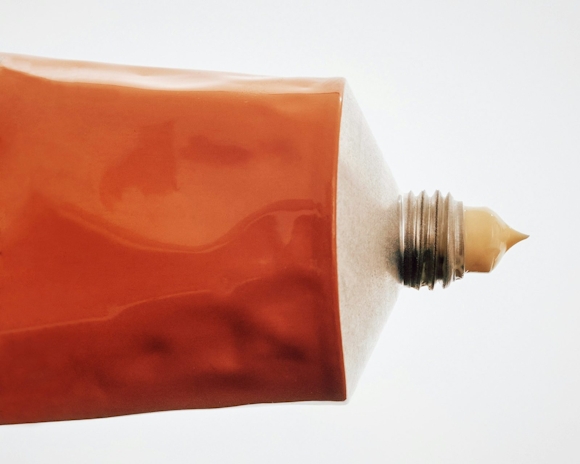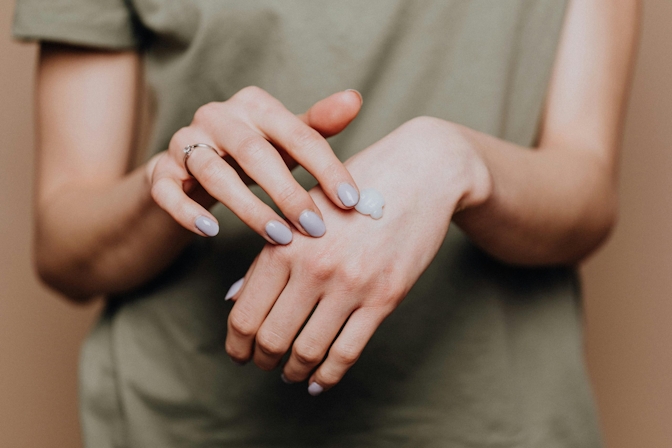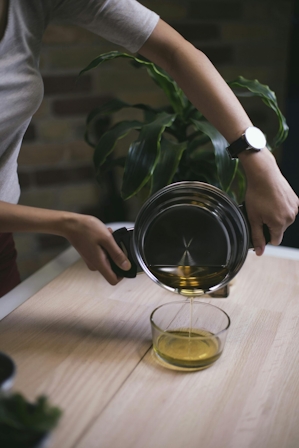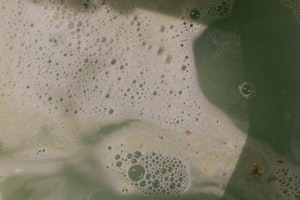
Photo by FANETTE GUILLOUD / Death To Stock
CBD Lotion Recipe: How to Make CBD Cream At Home
CBD topicals have incredible benefits for the skin from anti-aging to anti-inflammatory properties. Make yourself some in the comfort of home with our recipe.
In this article, we’ll cover:
- CBD lotion benefits
- How to make CBD lotion
- How to dose CBD lotion
Natural skincare is getting a lot of buzz lately, and for good reason.
Your skin is your body’s largest organ—it shields you from the elements, helps regulate temperature, and protects you from harmful pathogens and bacteria.
With such important roles to play, why not treat it to some botanical luxury with a homemade CBD cream?
CBD salves and lotions are making waves in skincare, but most brands come with a hefty price tag. So why not save your cash and make your own?
With just a little prep, you can whip up a fresh batch of infused topicals in under an hour.
CBD Lotion Benefits

Karolina Kaboompics / Pexels
Pain and Inflammation
According to Cedars-Sinai dermatologist and skin cancer surgeon Dr. Nima Gharavi, CBD topicals, like CBD lotions, may hydrate the skin and help with inflammation, especially certain inflammatory skin disorders.
Typically, these conditions are treated with topical corticosteroids, which come with unwanted side effects like skin thinning, eye issues, and irritation in sensitive areas. CBD might offer a more natural alternative, providing anti-inflammatory benefits without the drawbacks of traditional treatments.
Beyond inflammation, CBD topicals may also provide pain relief.
Long associated with easing aches, CBD has shown promising results in a 2022 study, where topical CBD significantly reduced arthritis-related pain compared to a placebo. This is likely due to CBD’s interaction with the body’s endocannabinoid system, which helps regulate pain, sleep, mood, and appetite.
Anti-Aging
There are two primary types of skin aging: intrinsic and extrinsic. Intrinsic aging is inevitable, as the skin naturally changes with age. As you grow older, the skin becomes softer, and you begin to lose collagen fibers and elasticity.
While modern inventions like Botox and other skin care technologies seek to remedy the situation, those hoping to discover the fountain of youth may have to wait a while.
Extrinsic aging, however, is something that each individual can influence. Extrinsic aging refers to external factors like the environment, pollution, UV radiation, and beauty routines. Over time, these outside factors can damage the skin, leading to sunspots, redness, acne, and all-around wear and tear. It is impossible to avoid all forms of extrinsic aging; however, your daily care routine, lifestyle, and diet can all make a difference.
Extrinsic aging is where CBD topicals may come in handy since it’s a potent antioxidant. In fact, a patent held by the U.S. government states that cannabinoids like CBD may be more potent antioxidants than vitamins C and E.
Antioxidants are natural remedies for free-radical damage. Free-radicals are produced naturally by the body and can contribute to aging over time.
Free radicals, however, are also produced by exposure to pollution, UV radiation, and other toxicants that are now commonplace in daily life. Needless to say, exposure to too many free radicals does not make for healthy skin. The antioxidant potential of CBD may make it a wonderful tool for protecting skin as it ages.
What The Research Says
Several studies have highlighted the effects of CBD on animal aging. In one study, researchers found that after ten weeks of CBD treatment (10mg/kg of body weight), 15-month-old rats had reduced aging markers in lung and liver tissues compared to those that did not receive CBD.
In roundworms (Caenorhabditis elegans), lifespan was increased by 18% with CBD treatment after one day, with their late-stage activity increasing by over 200% compared to those that did not receive CBD!
While human research is still catching up, early evidence suggests CBD holds serious potential for anti-aging benefits.
How To Make CBD Lotion - Homemade CBD Cream Recipe

This CBD body cream has a thick, whipped consistency and is ideal for dry and damaged skin.
An ultra-moisturizing body lotion, this cream uses nutrient-dense shea butter to soothe and soften inflamed skin. It also contains aloe vera gel—which has long been used to help heal sunburns and ease irritation—and vegetable glycerine—which draws water to the skin and maintains hydration.
This CBD lotion recipe uses CBD oil, which can be purchased around the U.S. and Canada.
However, those hoping to add some THC to the mixture can follow the exact same steps using THC oil or tincture.
CBD Lotion Ingredients
- ½ cup shea butter (preferably unrefined)
- ½ cup coconut oil
- ⅓ cup aloe vera gel
- 2 tbsp (⅛ cup) vegetable glycerine (optional)
- 2 tsp concentrated CBD oil or tincture
- Any fragrant essential oil
Cocoa butter can be used as an alternative to shea butter.
CBD Lotion Materials
- Double boiler
- Measuring cups
- Measuring spoons
- Spoon
- Spatula
- Handmixer or blender
- Glass container
Steps
- Measure all ingredients before beginning.
- Fill the bottom of a double boiler with an inch or two of water. If you do not have a double boiler, simply place a heat-proof bowl on top of a traditional cooking pot.
- Warm water over low to medium heat. Add the shea butter and coconut oil to the top of the double boiler.
- Gently melt the shea butter and coconut oil until there are no lumps, stirring frequently to combine the oils and prevent scorching.
- Once melted, turn off the heat and remove oils from atop the water. Transfer to a glass blender or heat-safe bowl.
- Allow the oil mixture to cool for at least one full hour, scraping down the sides of the bowl with a spatula if needed.
- Add aloe vera gel, vegetable glycerine, your desired amount of essential oil, and your desired amount of CBD oil.
- Use a hand mixer or blender to emulsify all ingredients and create a whipped consistency.
This recipe will keep for two weeks without refrigeration. For extended shelf life, consider adding vitamin E. This acts as a natural preservative. Extra lotion can be refrigerated for one month or longer in an air-tight container.
Simply let the mixture cool to room temperature before use.
Troubleshooting your Homemade Cannabis Cream:
Making your own skincare can be tricky. The most common problem? Not achieving your desired texture. Here’s how to troubleshoot the most common problems when making your own CBD cream:
Gritty texture: Whip your CBD body cream longer and consider adding more vegetable glycerine one tablespoon at a time.
Too thick: Add more aloe vera gel one tablespoon at a time, continue whipping until the desired consistency is achieved.
Too thin: Remelt an even ratio of shea butter and coconut oil, allow to cool, and blend into mixture one tablespoon at a time.
Not potent enough: Add more of your favorite CBD or cannabis oil and whip.
How to Calculate the Dosage for your CBD Lotion Recipe

If you’re using homemade cannabis cream to ease pain, muscle soreness, or inflammation, it may be useful to get a rough estimate of how much CBD or cannabis oil you are actually infusing into your lotion.
fourfivecbd offers an excellent example. The company was started by two professional rugby players, Dom Day and George Kruis. Without a doubt, these guys know a thing or two about using CBD topicals for recovery. The fourfivecbd Muscle Rub is uniquely formulated for pain, soreness, and inflammation. It also contains a carefully measured 300 milligrams of CBD isolate per container.
When making CBD skincare, it is best to start with a highly concentrated CBD oil or tincture. A highly concentrated solution will allow you to infuse more CBD without altering the consistency of the body cream.
The dosage of your DIY CBD cream will depend on the initial concentration of the CBD or cannabis oil.
Typically, CBD tinctures are measured in milligrams per milliliter. This recipe, however, uses cups and tablespoons. To get a ballpark idea of how much CBD is infused into your cream, you’ll have to do a little math.
If your dosage still is not strong enough after crunching the numbers, however, you may want to halve the contents of the primary oils in the recipe listed above in order to increase the concentration of CBD or cannabis oil in your end product.
The maximum yield of this recipe is about a cup and a half of CBD cream. However, the true yield of the moisturizer will likely be a little less. If you use 10 milliliters of a 37-milligram per milliliter CBD oil (about two teaspoons) in this recipe, a crude estimate places the dosage at approximately five milligrams of CBD per teaspoon of oil.
Yet, regardless of your end result, you can determine a ballpark estimate of the strength of your CBD cream by plugging in your specific numbers to the calculations here:
Step 1: Convert Cups to Milliliters
First, you need to convert the amount of lotion you have from cups to milliliters.
(Approximate amount of cups) X (0.236588 liters) X (1000 milliliters)
One and a half cups of lotion yields approximately 355 milliliters.
Step 2: Milligrams of CBD per Milliliter of Lotion
Next, you’ll need to figure out how many milligrams of CBD are in each milligram of lotion.
(Grams per milliliter of CBD Added X total milliliters added) ➗ (Total milliliters from step 1)
Step 3: Convert Milliliters to Teaspoons
It’s difficult to tell exactly how many milliliters of lotion you are spreading on your skin. So, for an easier visual, you can convert milliliters to teaspoons. That way, you can get a ballpark estimate of how much CBD you are actually applying to your skin.
(Answer from step 2) X (5 milliliters per teaspoon)
This will give you a rough total amount of CBD found in a teaspoon-sized dollop of your homemade CBD cream. However, it’s always best to assume that there is actually a little less than this, given that this simple math can only get you so far.
Herb Recommended Products:
READ MORE










